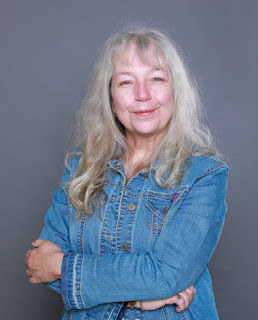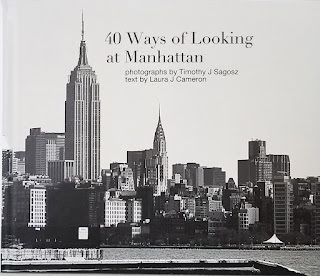Featuring Laura Cameron with her books An Abecedarium of Ornaments and 40 Ways of Looking at Manhattan

I'm thrilled to introduce Laura, who is one of my writing friends through the Natalie Goldberg Writing Course! Along with Stefania and Patricia, we have built a wonderful little group to help each other on our creative journeys! AND Laura has compiled a fascinating book about Christmas ornaments that I couldn't wait to share!!

Laura Cameron is the Editor at theWashington State Auditor’s Office. Her role ranges from story development torewrite to line-edits, making complex performance and accountability auditsinto readable, compelling reports. A writer and editor for 35+ years, she hasworked for state and county governments, community organizations, and privatebusinesses in the United States and United Kingdom. Laura earned her MA inJournalism at the University of Bournemouth, England, and her BA in medievalhistory, literature and music at SUNY Purchase. She serves as secretary on theEducation Fund Board of the American Copy Editors Society[https://aceseditors.org/], and is a past officer of the National Writers Unionand the UK’s Women Writers Network. She is also a director on the board of theConservation Burial Alliance [https://www.conservationburialallianc...]
Website: https://www.artforartssakepress.com
Author page on Amazon:https://www.amazon.com/stores/author/B07T8QD7HP
An Abededarium of Ornaments (on Amazon):
40 Ways of Looking at Manhattan available in hardback and paperback through print-on-demand. EmailLaura [at] artforartssakepress.com for details.
How many hours a day do you write?
Highly variable, and driven by projectdeadlines! My day gig allows me to work four, 10-hour days a week, whichdoesn’t leave me a lot of brainpower on those weeknights. On the remainingthree days, I write most diligently when I have a deadline, whether set by afreelance client or publication, or self-imposed. I would say four to fivehours a day, three days a week, when I’ve a project in hand. I participated inNaNoWriMo 2023, and wrote in 25-minute “sprints.” On weeknights, I managed twosprints totaling 60 minutes; on free days, especially over the five days ofAmerican Thanksgiving weekend, it was probably closer to five to seven hours aday to get my word count up.
How do you choose the stories you’llwrite?
The story calls out to me, and I listen. Ifit keeps talking, I’ll start jotting down ideas and making sketch diagrams,free-associating what kinds of material might fit into the book. Since I writenonfiction, and these days mostly memoir, the writing process and the resultingbooks gives me space to remember, grieve and celebrate my dear ones. Forexample, The Abecedarium of Ornaments captured in photographs and shorttales the happy memories attached to the hundreds of souvenir and specialornaments on 40 years of Christmas trees. 40 Ways of Looking at Manhattanhonored my late husband’s black-and-white photographs of our old home town. Thework-in-progress, Dad’s Cooking Tonight: A life in 52 recipes, tells hislife story through his 200+ cookbooks filled with dates and preparation notes.It was prompted by finally unpacking 15 or 20 boxes of Dad’s batterie decuisine, plus endless glassware and table settings, from my parents’ home.
What’s the most difficult part of theartistic process?
For me, recognizing that not every story --no matter how funny or meaningful or interesting to me -- belongs in this book.While researching Dad’s Cooking Tonight, I learned so much about Dad’sfirst family and Scots ancestors, I could write an entire 300-page book justabout them, but then it wouldn’t be his story anymore. For example, Tim’s deathwas incredibly important to me, but is a very small moment in the book becausethe narrative through-line follows my mother. She survived another six yearsafter my Dad died and three years after Tim’s passing. After her stroke, Itried to use tastes and aromas from his recipes, along with anecdotes from ourfamily’s past, to keep her memory active.
Where are you as a writer five yearsfrom now?
[puts on my rose-tinted glasses] Inaddition to seeing the paperback edition of Dad’s Cooking Tonight onbookstore shelves, I envision its sequel -- Dad’s Cooking Again Tonight:Recipes from a lifetime of travel -- selling briskly. I’ll use my thirdNaNoWriMo to draft a book about my mother’s growing up in the New York City ofthe 1920s and 1930s. Her mother’s story will add some fascinating detours.Gramma was a Lithuanian immigrant, arriving in Manhattan at the turn of thecentury, who found herself courted by a scion of a well-to-do doctor’s family.The Whites weren’t exactly the Astors, but they had deep American roots and didnot take kindly to their son’s choice of bride...
How many unpublished and half-finishedbooks?
I abandoned a coming-of-age novel aroundthe 140-page mark, 15 or more years ago. I realized I didn’t read enough ofthose kinds of stories to make my own terribly successful. I might return to itas memoir, since it was set in the club scene of Lower Manhattan in the days ofpunk and New Wave music -- a period having a bit of a fashion-moment thesedays. Otherwise: If I start it, I’m going to finish it, and I tell my friendsand colleagues what I’m doing to help ensure a little accountability!
Was there a person who encouraged youto write?
I had so many excess credits in high schoolthat I was determined to graduate a year early -- to meet state requirements,all I needed was a 12th grade English elective. The easiest classwas TV Studio, so I took that. The only other girl in the class wanted to domake-up and costuming, and the guys wanted to act, shoot and direct, so Ioffered to write quite a few scripts. The teacher took me aside at the end ofthe year and told me he thought I should seriously consider making writing mylife’s work. Oh, and once I graduated from college, I should marry a dentist tosupport me until I got my first Pulitzer/Emmy/Oscar. This would have been aswell idea except I was terrified of dentists: I ended up at a TV productioncompany but writing press release, not scripts. So much for my Emmy!
From apples, representing the Big Apple of her childhood, to a souvenir of York Minster that commemorated years of living and working in the United Kingdom, Laura Cameron has cataloged and described more than 300 ornaments. Far more than a laundry list, this memoir in photographs brings to life stories from four decades of Christmas trees.
There are camels of olivewood from the Holy Land and Italian ceramic ducks; wooden hedgehogs and reindeer of clothespins; stars, icicles, and snowflakes made of crystal, stainless steel, and antique tinsel. Every one has a story to tell, and because memory fades, each has its tale committed to the page in this unusual little abecedarium of ornaments. As the author notes, what is as random as the order of the alphabet? Only a Christmas tree, where eggs and elves share a branch with cats and steam trains, cardinals and baubles.
An Abecedarium of Ornaments (on Amazon):

It's well known that New Yorkers have strong opinions, and don't mind sharing them with friends and strangers alike. One of their favorite things to talk about is their nabe' -- their neighborhood -- which they are quick to tell you no one knows better than they do. This photo album is a little tribute to the island of Manhattan. It's told by a photographer and author who left its shores long ago, but returned regularly to see what had changed in their old neighborhoods.
40 Ways of Looking at Manhattan available in hardback and paperback through print-on-demand. Email Laura [at] artforartssakepress.com for details.



